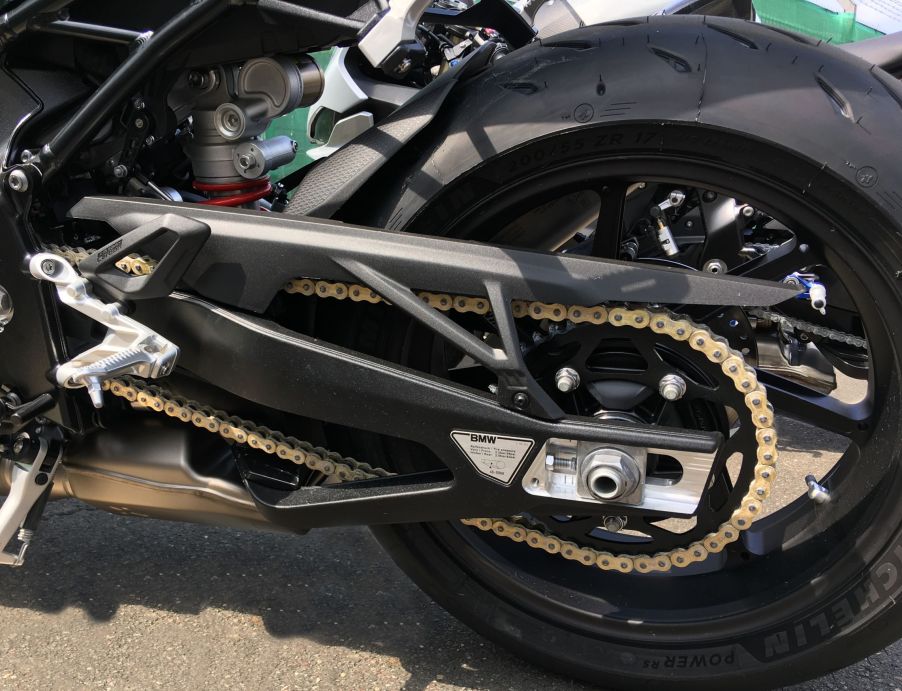
Shaft, Chain, Belt: What’s the Difference With Motorcycle Drive?
Whether you’re working on a car or motorcycle, some things stay the same. There are fluids to change, tires to replace, and brakes to bleed. But one of the biggest differences is that motorcycles have chains, and cars don’t. Except, not every bike has a chain. Many BMW models, for example, are shaft-driven. And cruisers like the Indian Scout Bobber are usually belt-drive motorcycles. So, what are the differences between them, and is one better than another from a maintenance or performance standpoint?
Chain-, shaft-, and belt-drive motorcycles do the same thing in different ways
Although motorcycle transmissions are arranged differently than car ones, the two have many of the same components. For example, the final drive on the transmission’s output shaft which sends power to the drive wheel/wheels. But unlike cars, which have their final drives in differentials, motorcycles have chains, shafts, or belts, Motorcyclist explains. They all send power from the engine to the rear wheel, but they do it differently.

Chain-drive is the most common type of final drive, Revzilla reports. As the name implies, this type of motorcycle uses a chain mounted on sprockets to link its rear wheel and transmission. As the output shaft spins, so does the chain, and thus the wheel.

Shaft-driven bikes are less common, though BMW isn’t the only manufacturer using them. The Moto Guzzi V7 and V85TT have shaft-drive, for example, as did the FN Four in the 1910s, RideApart reports. These motorcycles don’t have chains. Instead, the transmission sends power to a metal rod, which feeds into a wheel-mounted hub, RideApart explains. And nowadays, these components are usually enclosed in a housing.

Harley-Davidson used to have chain-driven models, but as of this writing, all of its motorcycles use belt-drive, MotorBikeWriter reports. And many other cruisers use it, too. These bikes work basically the same way as chain-drive bikes. However, instead of a metal chain, belt-drive motorcycles have a toothed rubber belt. And instead of sprockets, there are pulleys, ADV Rider reports.
What are the pros and cons of each type of drive?
Each type of final drive is roughly equally-effective at sending power to the rear wheel. However, the differences between them give each a distinct set of benefits and downsides. Some revolve around maintenance, while others involve how the bike rides.
Going with a motorcycle chain has several advantages. It’s the cheapest and the lightest system of the three, RideApart reports. It’s also the most efficient of the three, and the most adaptable. However, chain-driven motorcycles require the most maintenance, Motorcyclist reports. And you’ll also have to replace the chain and the sprockets regularly, Cycle World reports.
A belt-drive motorcycle, on the other hand, doesn’t need lubrication, Cycle World reports. It’s also quieter and doesn’t require tension adjustment. However, maintaining that tension requires a more complicated pulley system, one that doesn’t work well with extended suspension travel, Cycle World reports.

Plus, while a chain is made of metal, the belt is made of less-durable rubber or a similar compound. Hence why, for the upcoming Pan America adventure motorcycle, Harley-Davidson swapped belt-drive for chain-drive, Cycle World reports.
Shaft-drive motorcycles require less maintenance than either chain- or belt-drive models, MCN and Motorcyclist report. Their enclosed housings protect them from the weather and keep lubrication contained. Plus, they don’t wear out as quickly as a chain.
However, shaft-drive mechanisms are heavier and sap more power from the engine. They’re also more expensive to build and replace if they do fail. Plus, unlike with a chain or belt, older shaft-drive motorcycle can undergo ‘shaft jacking.’ If you open then quickly close the throttle, Newton’s third law means the shaft tries to “’ climb’…the back wheel,” MCN explains. That forces the bike’s rear to rise, which can be unsettling.
Even if your motorcycle doesn’t have a chain, it still needs maintenance
A motorcycle chain has more frequent maintenance intervals than a belt-drive system or a shaft. However, both of the latter two drives have their own service requirements, Motorcyclist reports.
For chain-drive motorcycles, the most common maintenance tasks are lubricating and cleaning the chain and checking its tension, Motorcyclist reports. Each bike has its own manufacturer-set requirements, though if you’re riding in rougher environments, such as off-road, you’ll likely have to shorten the intervals. And after the chain stretches enough, both it and its sprockets need to be replaced, Motorcyclist reports.
Belt-drive motorcycles have tension-checking intervals, too, albeit significantly longer ones. But if the belt or its pulleys are significantly damaged, it’s time for a replacement.
Maintaining a shaft-drive bike is even easier, provided the shaft itself isn’t broken. Just replace the used hypoid gear oil per the service interval, as well as the associated bolt washers, Motorcyclist reports. And keep an eye out for metal filings, which can indicate shaft wear.
Follow more updates from MotorBiscuit on our Facebook page.


